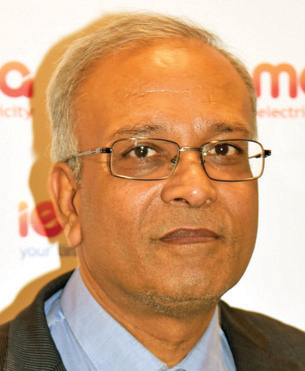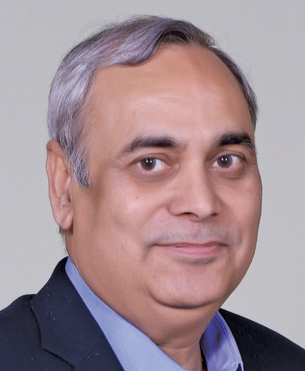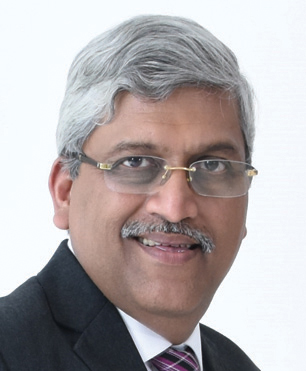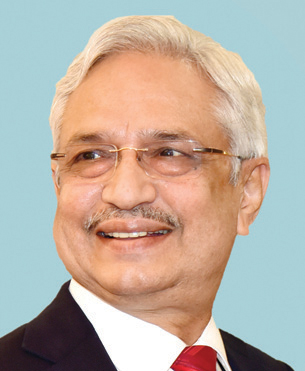The transmission and distribution (T&D) equipment market has witnessed a satisfactory performance on the back of government schemes such as the Pradhan Mantri Sahaj Bijli Har Ghar Yojana (Saubhagya) and Unnat Jyoti by Affordable Lighting for All (UJALA), although the operational aspect of the distribution segment continues to be a cause for concern. The digitalisation of operations to enhance efficiency and ensure grid stability in light of the large renewable energy penetration is gaining momentum. However, in the generation segment, equipment providers are facing headwinds, owing to the build-up of stressed assets and a declining trend in coal-based capacity addition, resulting in the under utilisation of manufacturing facilities. Leading equipment providers share their views…
How has the sector progressd in the past year? What have been the major positive and negative developments?

Harish Agarwal
The electrical and industrial electronics industry witnessed a record double-digit growth of 12.8 per cent in 2017-18. A substantial improvement in growth was experienced in the third and fourth quarters of 2017-18, which resulted in a sharp improvement in performance. The industry grew by 25 per cent in the third quarter and 14 per cent in the fourth quarter. Astonishing growth was registered in segments such as rotating machines (12 per cent), high tension motors (18 per cent), cables (20 per cent) and meters (28 per cent). Growth was also seen in transmission line towers due to an increase in demand in the domestic market.

Anil Chaudhry
The Indian energy sector has been witnessing continuous transformation over the past few years. Digitalisation and renewables are becoming increasingly relevant for meeting the growing demand in a sustainable and efficient way. If we talk about the electrical industry specifically, utilities are seeing consistent evolution in terms of power generation, transmission, capacity addition and distribution reforms. While T&D losses continue to pose a few challenges, initiatives like the 10-year tax exemption for solar energy projects, UJALA, rural electrification under the Deendayal Upadhyaya Gram Jyoti Yojana (DDUGJY), Saubhagya and Kisan Urja Suraksha Evam Utthaan Mahaabhiyan, the ongoing Integrated Power Development Scheme (IPDS) for urban electrical distribution strengthening, and the Ujwal Discom Assurance Yojana (UDAY) are making a positive contribution to achieving sustained industrial growth. However, the liquidity position in the market is impacting the progress of large projects, especially in the generation segment.

Vimal Kejriwal
The Indian power sector has witnessed significant growth in energy demand, generation capacity and T&D networks over the past year. During 2017-18, the sector witnessed a 5.3 per cent growth in installed capacity, with the addition of 17,170 MW, along with an addition of 23,119 ckt. km of transmission lines (growth of about 6 per cent over the previous year) and 86,193 MVA of substation capacity (growth of about 12 per cent). Generation from renewable sources too increased by 23 per cent as compared to 2016-17.
The sector continues to undergo transformation and radical changes. There has been a marked change in the customer portfolio, with an increase in the share of state utilities and private players as compared to earlier years. Last year, KEC won its single largest order of over Rs 10 billion from a private transmission line player and successfully broadened its customer base to include state utilities of Karnataka, Tamil Nadu, Andhra Pradesh, Telangana, West Bengal and Bihar, amongst others. We are also witnessing a migration to higher transmission voltages of up to 1,200 kV, the deployment of new technologies for bulk power transmission and the development of high capacity power transmission corridors. Another development is the shift towards the utilisation of monopoles, narrow-based towers and advanced conductor technologies like high-temperature low-sag conductors, and covered conductors, which are playing a crucial role in resolving right-of-way issues. KEC has been at the forefront of adopting new technologies; we have pioneered the use of covered conductor technology in India for Karnataka Power Transmission Corporation Limited, for which the company won the Innovative Schemes Award from the Karnataka government.
With regard to substations, new technologies such as gas-insulated substations (GIS) are gaining prominence, where KEC is an experienced player. We have executed several key GIS substations across the country, which include 765/400 kV GIS substations in Uttar Pradesh and Uttarakhand for Power Grid Corporation of India Limited, a 400/220 kV GIS substation in Tamil Nadu and a 220 kV GIS substation in Delhi. There is also a greater focus on innovative designs, solutions and modern construction technologies involving a high degree of mechanisation and digitalisation. KEC has been using drones to string power conductors and conducting aerial surveys in difficult terrain and utilising digital technology such as Light Detection and Ranging for topographic surveys. There is also an enhanced push towards renewable energy, with the government setting a target to augment renewable capacity to 175 GW by 2022, including 100 GW of solar power. KEC’s solar business has grown to become among the few businesses with the capability to execute large-scale projects of over 100 MW. The company is currently executing a large turnkey engineering, procurement and construction (EPC) project of 130 MWp for Andhra Pradesh Power Generation Corporation Limited.
On a broader note, the government’s significant thrust towards 24×7 Power for All, last-mile connectivity through 100 per cent rural electrification and the allocation of Rs 160 billion for Saubhagya continue to drive growth and improve the existing power scenario. This is expected to result in a net increase in demand for power transmission, which augurs well for EPC companies like us. Amidst all these positives, issues pertaining to smooth and timely project execution are still dominant by way of challenges such as right of way, land acquisition, and environment and forest clearances, which create an additional burden on EPC companies by way of time and cost overruns, and impacts project mobilisation. The government is cognisant of these issues and is working dedicatedly towards resolving them. This has resulted in some progress, by way of amendments to ease environmental clearances and an enhancement in the compensation levels for land acquisition. Meanwhile, the roll-out of the goods and services tax has impacted industries such as solar, with ambiguity in the applicability of taxes and uncertainty over import duty and safeguard duty.

Shailendra Roy
The power sector saw some positive developments in reform policies past year. However, the sector remains under stress despite the best intent and efforts of the government. The National Electricity Policy (NEP), published by the Central Electricity Authority (CEA) in March 2018, incorporated the views of Larsen & Toubro (L&T) and other stakeholders to arrive at a balanced view on the growth of thermal power with an impetus to renewables – the right step for well-adjusted development towards future energy security. The NEP has also stated the need for retiring around 48 GW of old and inefficient thermal power plants (TPPs) and replacing these with efficient supercritical units by 2026-27. We hope the utilities will speed up things on this front. The Scheme for Harnessing and Allocating Koyla (Coal) Transparently in India (SHAKTI), a scheme for allocating coal linkages to plants with power purchase agreements but without fuel supply agreements, can play a significant role in reviving stressed assets. The first round of auctions under the scheme resulted in 10 private plants receiving coal allocations.
The new environmental norms of December 2015 for TPPs mandate the installation of flue gas desulphurisation (FGD) systems. The CEA finalised the plan for a phased implementation of FGD systems by 2021-22. As a result, we have seen FGD tenders of approximately 39 GW in 2017-18, primarily by NTPC. The momentum has sustained in the first quarter of 2018-19 with about 11 GW of tenders. This will boost thermal power generation in a cleaner way and reiterates India’s commitment to a more responsible usage of fossil fuels. Regarding nuclear power, a positive development was cabinet approval for the construction of 10 indigenous pressurised heavy water reactors (PHWRs) of 700 MW each, in fleet mode, by 2031. These projects will provide a boost for the domestic manufacturing of key equipment.
India achieving 100 per cent village electrification in April 2018 was a significant milestone for the government, which is now looking at providing last-mile electricity connectivity and 100 per cent household electrification under Saubhagya by December 2018. This may lead to even higher electricity demand growth than NEP projections. We hope the government will plan sufficient capacity addition to meet future demand. One of the main areas of concern is the financial health of major power utilities. The last two years have seen aggregate technical and commercial (AT&C) losses coming down by about 2 per cent to 18.74 per cent under UDAY, and the gap between the average cost of supply (ACS) and the average revenue realised (ARR) per unit of power reducing by around 60 per cent to 23 paise per unit. However, meeting the end 2018-19 targets (AT&C losses of 15 per cent and zero ACS-ARR gap) would be challenging.
The power sector has the maximum non-performing assets (NPAs) among all sectors, but a successful resolution with a clear roadmap for several NPAs still eludes us.

M.S. Unnikrishnan
Capacity addition in the thermal power segment has been far below par in the past year. The same was the case with the wind segment. Even solar power capacity addition did not gather the expected level of momentum. Overall, it was a disappointing year for the power sector. On a positive note though, the commencement of the resolution of stranded power assets fuelled by the Insolvency and Bankruptcy Code is likely to see a majority of the assets moving into the realm of performing ones. Once these issues are resolved, new capacity addition can begin.
What are the biggest unresolved challenges for the sector?
Harish Agarwal
Ensuring the availability of affordable uninterrupted electricity continues to be a major thrust area for the government. Renewable energy is another thrust area. Besides, efforts are on to clear the bottlenecks in the way of setting up large power plants. After addressing the major concern over inadequate coal availability, the focus has now shifted to the T&D segment. The poor financial health of discoms is a major concern for both the government and our members. The high T&D losses continue to be a cause for worry. The government is working on an action plan. We have been asked to provide our suggestions. The government is also working aggressively on two major power-related schemes: the IPDS and DDUGJY. Our inputs are being provided through product divisions.
Anil Chaudhry
Climate change and the increasing carbon footprint are some of the most glaring challenges facing the energy sector, and call for a move towards clean, renewable sources of energy. Around 40 per cent of the global emissions could be prevented with energy-efficiency measures, according to the International Energy Agency.
The challenge is that our energy consumption is expected to double by the year 2050, electricity consumption is set to double by 2030, and there is an increasing need to control the carbon footprint. At the same time, approximately 300 million people in the country are without access to electricity, and another 400 million or so have access for only five to six hours a day. The adoption and seamless integration of renewable energy, and the provision of sustainable energy for all through digitalisation are what the sector and our world need today.
Shailendra Roy
A mere 20-30 per cent of the domestic manufacturing capacity is utilised. In 2017-18, the orders for new domestic coal projects stood at just around 5 GW, against a manufacturing capacity of around 23 GW. L&T and other organisations had invested heavily in setting up manufacturing capacities for supercritical boilers and turbine generators in the earlier part of the decade. While some manufacturers have exited the market, the battle for survival among other EPC and manufacturing companies has led to aggressive bidding due to limited opportunities, resulting in eroded operating margins.
While renewables’ growth will be a focus area, the hidden costs of renewable energy integration into the grid, load balancing and underutilised thermal capacity need to be factored in to bring about a balance. Thermal plants are essential to meet the base load and reliability criteria for industrial demand. These, however, have long gestation periods. In the absence of a sense of urgency for planning these projects now, we may face energy shortages over the next five to ten years.
Regulatory overhaul and financial restructuring have taken place repeatedly for stressed assets. However, a successful resolution is yet to materialise. While efforts by the government to revive these assets have shown some results, recent hardball measures such as the Reserve Bank of India’s stand on strict adherence to 180 days for resolution will further aggravate the issue. Again, the haircuts required to be absorbed by banks to bring these projects on track have been a perennial point of concern, with banks now considering referring all stressed loans to bankruptcy courts.
With a high exposure to the power sector, banks are reluctant to finance power projects, including for FGD installation. While the Association of Power Producers has requested the power ministry to designate the Rural Electrification Corporation and Power Finance Corporation as the nodal financing institutions for pollution control equipment, I believe the government can give a further impetus to FGD installation by providing easier financing terms, low-interest loans and other pertinent incentives.
M.S. Unnikrishnan
The existing NPAs and the possibility of a few more being added to the list are the biggest challenges for the power sector, going forward. Barring a few entities, most of the private and public power companies have a negative balance sheet. Unless they move into a green zone where they not only regain their health to repay loans but also become strong enough to borrow and set up fresh capacities, this industry will find it challenging to grow.
What are the market opportunities that you foresee in the power equipment industry in the next one to two years?
Harish Agarwal
India is firmly set on a path of economic growth, which is estimated to usher in prosperity like never before. This economic prosperity will need to be built on the back of significant transformations across several facilitating elements, the primary ones being infrastructure build-out, energy availability and sustainability. The government’s Make in India programme has placed the country on the world map as a manufacturing hub, giving global recognition to the economy. India is expected to become the fifth largest manufacturing country in the world by the end of 2020.
Anil Chaudhry
The power equipment industry is segmented into generation and T&D. While both the markets are estimated to show a comparable growth momentum in the future, the growth witnessed by the T&D segment will be at least three times that of the generation segment. With more renewable energy-based generation, the need for creating a dedicated infrastructure for T&D networks will also be important in order to make these sources of generation completely grid integrated.
Vimal Kejriwal
The total market size of the electrical equipment industry in India is anticipated to reach $100 billion by 2022. The rising standard of living that contributed significantly to the increasing per capita consumption of power, coupled with the growth in exports of equipment such as transmission towers, cables and conductors, and insulators has resulted in the overall growth of this sector. With various government infrastructure initiatives such as Power for All, the green energy corridors project and 100 per cent electrification of railways, and the increased focus on renewables, we foresee a considerable uptick in the demand for transmission towers, cables and conductors along with allied equipment in the coming years, unfolding tremendous opportunities. This also augurs well for companies such as KEC that have their own manufacturing set-up. We are one of the few EPC companies that have an extensive set-up to manufacture transmission towers, hardware and structures for substations, solar and railways, at Nagpur, Jabalpur and Jaipur, by leveraging the latest technologies and adopting best-in-class equipment. Our two cable manufacturing units located at Vadodara and Mysore produce a complete range of products, viz., power, instrumentation and control, telecom, solar and railway contact and catenary overhead conductors and railway signalling cables.
In terms of exports, nearly 50 per cent of our revenues come from transmission exports to regions such as Africa, the Middle East and North Africa, and SAARC and Eastern Partnership countries, where KEC has significant project presence.
Shailendra Roy
Cabinet approval for the construction of 10 indigenous PHWRs will boost domestic manufacturing. L&T is hoping to contribute significantly to these projects, both in terms of manufacturing as well as construction. FGD is the next major opportunity. With approximately 31 GW of FGD retrofit orders decided, the momentum is likely to continue. Recently, the power ministry wrote to the Central Electricity Regulatory Commission for treating FGD costs as pass-through under change in law, and this should augur well. Annual FGD ordering of 40-45 GW for the next two to three years is a must-do for the CEA plan implementation, provided state utilities and private developers follow suit.
India is one of the largest prospective markets for battery storage technologies because of ambitious renewable energy capacity addition targets and projections of steep ramping requirement, considering the daily net load (after renewable energy sources) curve. Construction of the first grid-scale energy storage and grid stabilisation system of 10 MW has been initiated. Energy storage systems are also a solution to distributed generation (in areas with high T&D infrastructure set-up costs) and for grid frequency stabilisation. I would also like to point out that there is a global shift towards digital technology and we see immense potential for its application in the power sector for improving operational efficiencies, predictive maintenance and flexible operation through the use of machine learning techniques. This opens up the possibility of value migration from original equipment manufacturers to digital solution providers. Applications in grid optimisation and energy management are also expected to gather pace.
M.S. Unnikrishnan
Renewable power in the form of solar, wind, biomass and geothermal, and even nuclear will gather momentum in the next few years. Fresh addition of fossil fuel-based thermal energy will only be limited to owners of healthy balance sheets. But this is an inevitable necessity to support the next phase of the economic growth of our country that has already displayed green shoots.
